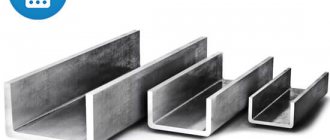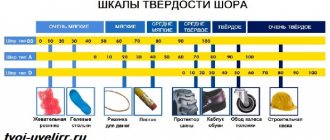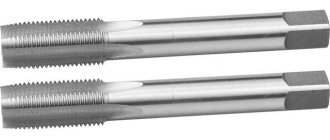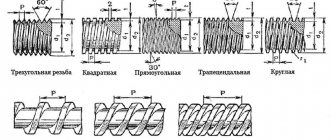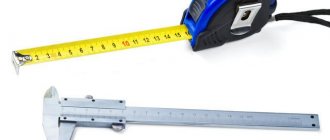Hello readers of seoslim.ru! The inch (inch) is a unit of measurement with a long history. Its name is derived from the Dutch word meaning thumb.
Before the widespread introduction of the metric system, such a unit was used throughout Europe, including in Russia (it was introduced by Peter I), and the meaning varied in each country.
Nowadays the English inch is used, for example in the USA, Great Britain and Canada it is used in everyday life.
In other countries, inchi is used to measure technical parameters.
English system of measures
Despite the fact that the decimal number system (positional number system in integer base 10, one of the most common systems; it uses the numbers 1, 2, 3, 4, 5, 6, 7, 8, 9, 0, called Arabic numerals ; it is assumed that base 10 is associated with the number of fingers on a person’s hands) is very common in modern life, and it is not uncommon to find English and American measures of calculation... The English system of measures is used in the USA, Myanmar and Liberia. Some of these measures in a number of countries differ somewhat in size, so below are mainly rounded metric equivalents of English measures, convenient for practical calculations.
How are inches indicated on drawings?
Here is a typical example of how to determine that the dimensions in a drawing are in inches. It is especially significant when the scale grid has noticeably larger squares.
Wikipedia describes several options for the origin of the inch, but historically it is generally accepted that the inch was defined as the width of the thumb. By the way, the width of my thumb corresponds to this assumption))) It is also important to note that inches are usually denoted by integers and ordinary fractions (with denominators 2, 4, 8, 16), and not by decimals.
Length measures
The variety and accuracy of modern measuring instruments is amazing. But what did our ancestors use in the absence of measuring instruments? To measure length, our ancestors used the measurements of their own body - fingers, elbows, steps...
One of the most common measures of length is the mile. The mile is used to measure the distance of air and land routes.
A mile (from the Latin mille passuum - a thousand double steps of Roman soldiers in full armor on the march) is a travel measure for measuring distance, introduced in Ancient Rome. The mile was used in a number of countries in ancient times, as well as in many modern countries before the introduction of the metric system. In countries with a non-metric system of measures, the mile is still used today. The size of the mile varies in different countries and ranges from 0.58 km (Egypt) to 11.3 km (Old Norse mile). Back in the 18th century, Europe had 46 different units of measurement called miles.
British and American (statutory) mile = 8 furlongs = 1760 yards = 5280 feet = 1609.34 meters ( 160934.4 centimeters ).
This unit of length is now commonly used in the United States to measure road length and speed.
A nautical mile is a unit of distance used in shipping and aviation.
According to the modern definition, adopted at the International Hydrographic Conference in Monaco in 1929, the International Nautical Mile is equal to exactly 1852 meters . The nautical mile is not an SI unit, however, according to the decision of the General Conference on Weights and Measures, its use is permitted, although not recommended. There is no generally accepted designation; sometimes the abbreviations “NM”, “nm” or “nmi” (from the English nautical mile ) are used. It should be noted that the abbreviation “nm” coincides with the officially accepted designation of nanometer.
International nautical mile = 10 cables = 1/3 nautical league
UK nautical mile before the transition to the international system (before 1970) = 1853.184 meters .
US nautical mile before the transition to the international system (before 1955) = 1853.248 meters or 6080.20 feet .
Foot (Russian designation: foot; international: ft, and also ' - stroke; from English foot - foot) is a unit of length in the English system of measures. The exact linear value varies from country to country. In 1958, at a conference of English-speaking countries, participating countries unified their units of length and mass. The resulting “international” foot became exactly 0.3048 m . This is what is most often meant by “foot” nowadays.
The inch (Russian designation: inch; international: inch, in or ″ - double stroke; from Dutch duim - thumb) is a non-metric unit of measurement of distance and length in some systems of measures. Currently, an inch usually means the English inch used in the USA, equal to 25.4 mm .
Yard is a British and American unit of measurement of distance. Currently, a metric yard is equal to three metric feet ( 36 inches ) or 91.44 cm . Not included in the SI system. There are several versions of the origin of the name and size of the yard. A large measure of length, called the yard, was introduced by the English king Edgar (959-975) and was equal to the distance from the tip of His Majesty’s nose to the tip of the middle finger of his outstretched hand. As soon as the monarch changed, the yard became different - it lengthened, since the new king was of a larger build than his predecessor. Then, on the next change of king, the yard became shorter again. Such frequent changes in the unit of length created confusion. According to other versions, a yard is the circumference of the monarch's waist or the length of his sword. King Henry I (1100-1135) legalized a permanent yard in 1101 and ordered a standard to be made from elm. This yard is still used in England (its length is 0.9144 m ). The yard was divided into 2, 4, 8 and 16 parts, called respectively half-yard, span, finger and nail.
Line is a unit of distance measurement in Russian, English (English line) and some other systems of measures. The name came into Russian through Polish. linea or germ. Line from lat. līnea - linen twine; the strip drawn by this string. In the English system of measures, 1 line (“small”) = 1⁄12 inches = 2.11666666... mm . This unit was rarely used, since the technique used tenths, hundredths and thousandths (“mils”) of an inch. Measurements in biology and typography used this unit, abbreviating it as "(outside these areas, the line was denoted as "', and " was and is used to denote the inch). The (large) lines measure the caliber of the weapon.
League is a British and American unit of distance measurement.
1 league = 3 miles = 24 furlongs = 4828.032 meters .
The league value has long been used in naval battles to determine the distance of a cannon shot. Later it began to be used for land and postal affairs.
Conversion of fractional inches
Sometimes fractional fractions of an inch are used (½, ¾, etc.). To convert them to centimeters and millimeters, you need to carry out more complex calculations: divide 2.54 or 25.4 by the denominator of the fraction and multiply by the numerator.
Example calculations in millimeters:
Thus, 5/8'' = 15.875 mm or 1.5875 cm. Using the same scheme, you can calculate any values.
Converting fractional inches to centimeters explains why the world industry does not switch to the metric system and does not abandon inches.
Dimensions in non-systemic units are much shorter, but in metric units the result is a long and awkward fraction.
It is inconvenient to use, and completely changing the technical process for the sake of convenience of designation is too expensive. It is easier and more convenient to use inchi in those areas where it is accepted.
The most common sizes in fractional units:
Measures of liquid and granular bodies
Basic measures:
Barrel (English barrel - barrel) is a measure of the volume of bulk substances and liquids, equal to a “barrel”. Used to measure volume in economic calculations and in some countries.
To measure the volume of bulk solids, there was a so-called “English barrel”: 1 English barrel = 4.5 bushels = 163.66 liters . In the US, the standard liquid barrel is 31.5 US gallons, that is: 1 US barrel = 31.5 US gallons = 119.2 liters = 1/2 hogshead .
However, when measuring beer volume (due to tax restrictions), the US uses the so-called standard beer barrel , which is equal to 31 US gallons (117.3 liters).
Also in the USA, a unit called a “dry barrel” , which is equal to 105 dry quarts (115.6 liters) .
For the most frequently used concept of a barrel in the world (namely, for oil), there is a special measure that is different from all of those listed (Oil Barrel).
1 Oil barrel = 158.987 liters . International designation: bbls.
Bushel is a unit of volume used in the English system of measures. Used for measuring bulk goods, mainly agricultural, but not liquids. Abbreviated as bsh. or bu.
In the British Imperial System of Measures for bulk solids: 1 bushel = 4 pecks = 8 gallons = 32 dry quarts = 64 dry pints = 1.032 US bushels = 2219.36 cubic inches = 36.36872 l (dm³) = 3 pails .
In the American system of measures for bulk solids: 1 bushel = 0.9689 English bushels = 35.2393 l ; according to other data: 1 bushel = 35.23907017 l = 9.309177489 US gallons .
In addition, a bushel is a container for storing and transporting apples. In international trade, a bushel typically refers to a box weighing 18 kg.
Gallon (English gallon) is a measure of volume in the English system of measures, corresponding to 3.79 to 4.55 liters (depending on the country of use). Typically used for liquids, in rare cases for solids. The units of a gallon are the pint and the ounce. An American gallon is equal to 3.785411784 liters. A gallon was originally defined as the volume of 8 pounds of wheat. A pint is a derivative of a gallon - one eighth of it. Later, other varieties of the gallon were introduced for other products and, accordingly, new varieties of pints appeared. America adopted the British wine gallon, defined in 1707 as 231 cubic inches , as the primary measure of liquid volume. This is where the American liquid pint was developed. The British corn gallon ( 268.8 cubic inches ) was also adopted as a measure of the volume of bulk solids. This is where the American dry pint comes from. In 1824, the British Parliament replaced all variants of the gallon with one imperial gallon, defined as 10 pounds of distilled water at 62 °F ( 277.42 cubic inches ).
The difference between the American gallon and the English gallon is:
- US gallon ≈ 3.785 liters;
- English gallon = 4.5461 liters.
In the US, the standard liquid barrel is 42 US gallons, that is: 1 US barrel = 42 US gallons = 159 liters = 1/2 hogshead. However, when measuring beer volume (due to tax restrictions), the US uses the so-called standard beer barrel, which is equal to 31 US gallons (117.3 liters).
Ounce (lat. uncia) is the name of several units of mass, as well as two measures of volume of liquid bodies, one unit of force and several monetary units formed as a twelfth of another unit. The term comes from ancient Rome, where an ounce meant a twelfth of a libra. It was one of the main weight units of medieval Europe. Today it is used when trading precious metals - the troy ounce, as well as in countries where weight is measured in pounds (for example, the USA). A quart (English quart from Latin quartus - quarter) is a unit of volume used in the USA, Great Britain and other countries to measure bulk or liquid volumes, equal to a quarter of a gallon.
- 1 quart = 2 pints = 1/4 gallon.
- 1 US dry quart = 1.1012209 liters.
- 1 US quart for liquids = 0.9463 liters.
- 1 imperial quart = 1.1365 l.
Area measures
Acre (English acre) is a land measure used in a number of countries with the English system of measures (for example, in the UK, USA, Canada, Australia and others). Originally it denoted the area of land cultivated per day by one peasant with one ox.
1 acre = 4 ore = 4046.86 m² ≈ 0.004 km² (1/250 km²) = 4840 square yards = 888.97 square fathoms = 0.37 dessiatines = 0.405 hectares = 40.46856 ar = 1/30 land yards = 1 /640 square miles
Township (English township - village, town) is an American unit of measurement of land area, which is a plot of land measuring 6 × 6 miles = 36 square meters. miles = 93.24 sq. km .
Hyde (English hide - plot, plot of land) - an ancient English land measure, originally equal to a plot of land that could feed one family, is 80-120 acres or 32.4-48.6 hectares .
Rood (English rood - piece of land) - land measure = 40 sq. gender = 1011.68 sq. m .
Ar (English are from Latin area - area, surface, agricultural land) - a land measure in the Anglo-American and metric system of measures, is a plot of land measuring 10x10 m and equals 100 square meters. m or 0.01 hectares , in everyday life it is called “weaving”.
Cubic volume measures
Ton (English ton(ne), ton, tun from French tonne - large wooden barrel) is a unit of measurement for various purposes. Before the adoption of the metric system, the ton measure was widely used in Europe and America as a measure of the capacity of bulk and liquids, a measure of weight and a land measure. In the Anglo-American system of measures, a ton is:
1. Measure of cubic volume
- Register ton (register) - a unit of measurement of the capacity of merchant ships = 100 cubic meters. ft = 2.83 cu. m .
- Freight ton (freight) - a unit of measurement of a ship's cargo - 40 cubic meters. ft = 1.13 cu. m .
2. Trade weight measure
- Large ton (gross, long) = 2240 pounds = 1016 kg .
- Small ton (net, short) = 2000 pounds = 907.18 kg .
- A ton in the metric system is defined as 1000 kg or 2204.6 pounds .
3. Old English measure of liquid capacity (tun) (mainly for wine and beer) = 252 gallons = 1145.59 l .
Standard (English standard - norm) - a measure of the volume of lumber = 165 cubic meters. ft = 4.672 cu. m .
Cord (English cord from the French corde - rope) is a measure of the volume of firewood and round timber. A gross cord is equal to a 4x4x8 foot stack of firewood = 128 cubic meters. ft = 3.624 cu. m . Small cord (short) for round timber = 126 cubic meters. ft = 3.568 cu. m .
Stack (English stack - heap, pile) - English measure of the volume of coal and firewood = 108 cubic meters. ft = 3.04 cu. m.
Load (English load - load, heaviness) - a measure of the volume of wood, equal to 40 cubic meters for round timber. ft or 1.12 cu. m ; for lumber - 50 cubic meters. ft or 1,416 cu.m. m .
Inch designation
In technical documentation, three inch designations are accepted:
These are international designations that are used in all countries.
The last character ( '' ) is the most common - it does not cause discrepancies, it cannot be mistaken for any other. The designation Inch or In is more common in English-speaking countries.
In the metric system, inch is not used and therefore has no designation. It is also impossible to form fractional or multiple units (microinch or kiloinch) from it.
Measures rarely used in everyday life
Barleycorn (English barleycorn - barley grain) length of barley grain = 1/3 inch = 8.47 mm.
Mil (English mil, abbreviated from mille - thousandth) is a unit of measurement of distance in the English system of measures, equal to 1⁄1000 inches . Used in electronics and to measure the diameter of thin wire, gaps or thickness of thin sheets. Also denoted as th.
1 mil = 1⁄1000 inch = 0.0254 mm = 25.4 micrometers
Hand (hand; English hand - “hand”) is a unit of measurement of length in the English system of measures. Used to measure the height of horses in some English-speaking countries, including Australia, Canada, the Republic of Ireland, the United Kingdom and the United States. It was originally based on the breadth of the human hand. In English-speaking countries, abbreviations of this unit of measurement to “h” or “hh” are common.
hand = 4 inches = 10.16 cm .
Chain (ch) (English chain - chain) is an outdated British and American unit of measurement of distance, equal to 20.1168 meters .
1 chain = 100 links = 1⁄10 furlong = 4 rods = 66 feet = 20.1168 meters
Furlong (Old English furh - furrow, rut, and Old English long - long) is a British and American unit of distance measurement.
1 furlong = ⅛ mile = 10 chains = 220 yards = 40 rods = 660 feet = 1000 links = 201.16 m.
5 furlongs are approximately equal to 1.0058 km.
The furlong is currently used as a unit of distance in horse racing in the UK, Ireland and the USA.
Hand (English hand - hand) - a measure of length, initially equal to the width of the palm, is 4 inches or 10.16 cm . Horses' height is usually measured using the palm of their hand.
Fathom (English fathom from Anglo-Saxon fǽthm from German faden - to grasp) is a measure of length, initially equal to the distance between the ends of the fingers of outstretched hands and is 6 feet or 1.83 m . This measure is used mainly in maritime affairs to determine the depth of water and in mountain (mine) measurements.
El (English ell from Swedish aln - cubit) is an old English measure of length, possibly originally equal to the length of the entire arm, containing 45 inches or 1.14 m , used for measuring fabrics. Cubit (English cubit from Latin cubitus - elbow) is an old English measure of length, originally equal to the distance from the elbow to the end of the middle finger of an outstretched hand, contains from 18 to 22 inches or 46-56 cm .
Span (English span) - a measure of length, initially equal to the distance between the ends of the thumb and little finger, stretched in the plane of the hand, is 9 inches or 22.86 cm .
Link (English link - chain link) is a measure of length used in geodetic and construction work: 1 geodetic link = 7.92 inches = 20.12 cm ; 1 construction link = 1 foot = 30.48 cm .
Finger (English finger - finger) - a measure of length equal to the length of the middle finger, contains 4.5 inches or 11.43 cm . To determine the depth of water, a measure equal to the width of a finger is used, containing 3/4 inch or 1.91 cm.
Nail (English: nail - needle) is an ancient measure of length for fabrics, equal to 2 1/4 inches or 5.71 cm.
Kabeltov (English cable's length from the word kabeltouw - sea rope) is a marine measure of length, initially equal to the length of the anchor rope. In international maritime practice, cables are 0.1 nautical miles and equal to 185.2 m . In England, 1 cable contains 680 feet and is equal to 183 m . In the USA , 1 cable contains 720 feet and is equal to 219.5 m .


